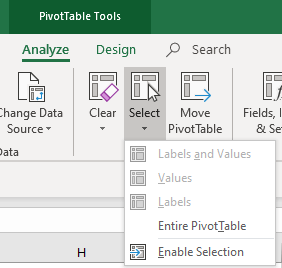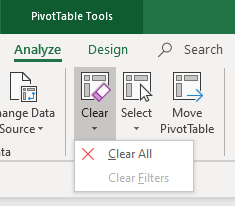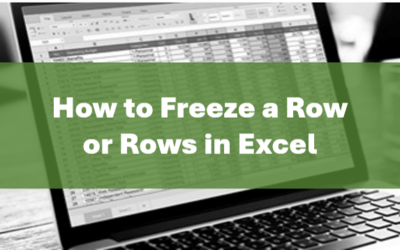Delete a Pivot Table in a Microsoft Excel Workbook
by Avantix Learning Team | Updated June 19, 2020
Applies to: Microsoft® Excel® 2010, 2013, 2016, 2019 and 365 (Windows)
A pivot table can be deleted in an Excel workbook in several ways. You can delete a pivot table, convert a pivot table to values or clear data and customizations from a pivot table to reset it. When a pivot table is created from source data in a workbook, Excel creates a pivot cache in the background. If you delete a pivot table or a source worksheet with the original data, Excel still retains the cache.
Recommended article: 10 Great Excel Pivot Table Shortcuts
Do you want to learn more about PowerPoint? Check out our virtual classroom or live classroom PowerPoint courses >
Deleting a pivot table
To delete a pivot table:
- Select a cell in the pivot table.
- Click the PivotTable Tools Analyze or Options tab in the Ribbon.
- In the Actions group, click Select. A drop-down menu appears.
- Click Entire PivotTable.
- Press Delete.
Below is the Select All command in the Ribbon:
You can select an entire pivot table by selecting a cell in the pivot table and then pressing Ctrl + A. However, if you have applied filters in the pivot table, Ctrl + A will not select the entire pivot table.
You can also delete a pivot table by deleting the worksheet on which it appears (assuming there is no other data on the sheet) or by deleting all of the rows on which the pivot table appears.
Deleting a pivot table and converting it to values
You can delete a pivot table and convert it to values. This can be useful if you want to share the pivot table summary information with clients or colleagues.
To delete a pivot table and convert it to values:
- Select a cell in the pivot table.
- Click the PivotTable Tools Analyze or Options tab in the Ribbon.
- In the Actions group, click Select. A drop-down menu appears.
- Click Entire PivotTable.
- Right-click any cell in the selected pivot table.
- Click Copy. You can also press Ctrl + C.
- Click the Home tab in the Ribbon.
- In the Clipboard group, click Paste. A drop-down menu appears.
- Click Paste Values. The pivot table should be deleted and replaced with values.
Below is the Paste drop-down menu in Excel:
If you copy and paste a pivot table using Ctrl + C and then Ctrl + V, Excel will make a copy of the pivot table, not the values.
You can also copy and paste pivot table values in another worksheet or workbook as well. If you press Ctrl + C and then Ctrl + Alt + V, Excel will display the Paste Special dialog box and you can then click Values and click OK. You can then delete the original pivot table if you want.
Deleting pivot table filters, labels, values and formatting
You also have the option of resetting a pivot table by deleting pivot table filters, labels, values and formatting but retaining the pivot table.
To delete pivot table data:
- Select a cell in the pivot table.
- Click the PivotTable Tools Analyze or Options tab in the Ribbon.
- In the Actions group, click Clear. A drop-down menu appears.
- Click Clear All.
- Add or remove fields in the Pivot Table Fields task pane.
- Right-click and select Refresh to refresh the pivot table.
Below is the Clear All command in the Ribbon in Excel:
The data connection, placement of the pivot table and the pivot table cache remain intact. If there is a pivot chart associated with the pivot table, the Clear All command also removes related pivot chart fields, chart customizations and formatting.
If pivot tables are sharing a data connection or if you are using the same data between two or more pivot tables, then if you select Clear All for one pivot table, you could also remove the grouping, calculated fields or items and custom items in shared pivot tables. A dialog box should appear if Excel is going to remove items in shared pivot tables and you can cancel the operation.
Subscribe to get more articles like this one
Did you find this article helpful? If you would like to receive new articles, join our email list.
More resources
How to Remove Blanks in a Pivot Table in Excel (6 Ways)
3 Excel Strikethrough Shortcuts to Cross Out Text or Values in Cells
How to Convert Seconds to Minutes and Seconds in Excel Worksheets
How to Change Commas to Decimal Points in Excel and Vice Versa (5 Ways)
10 Excel Flash Fill Examples (Extract, Combine, Clean and Format Data with Flash Fill)
Related courses
Microsoft Excel: Intermediate / Advanced
Microsoft Excel: Data Analysis with Functions, Dashboards and What-If Analysis Tools
Microsoft Excel: Introduction to Visual Basic for Applications (VBA)
Our instructor-led courses are delivered in virtual classroom format or at our downtown Toronto location at 18 King Street East, Suite 1400, Toronto, Ontario, Canada (some in-person classroom courses may also be delivered at an alternate downtown Toronto location). Contact us at info@avantixlearning.ca if you'd like to arrange custom instructor-led virtual classroom or onsite training on a date that's convenient for you.
Copyright 2024 Avantix® Learning
You may also like
How to Replace Zeros (0) with Blanks in Excel
There are several strategies to replace zero values (0) with blanks in Excel. If you want to replace zero values in cells with blanks, you can use the Replace command or write a formula to return blanks. However, if you simply want to display blanks instead of zeros, you have two formatting options – create a custom number format or a conditional format.
What is Power Query in Excel?
Power Query in Excel is a powerful data transformation tool that allows you to import data from many different sources and then extract, clean, and transform the data. You will then be able to load the data into Excel or Power BI and perform further data analysis. With Power Query (also known as Get & Transform), you can set up a query once and then refresh it when new data is added. Power Query can import and clean millions of rows of data.
How to Freeze Rows in Excel (One or Multiple Rows)
You can freeze one or more rows in an Excel worksheet using the Freeze Panes command. If you freeze rows containing headings, the headings will appear when you scroll down. You can freeze columns as well so when you scroll to the right columns will be frozen.
Microsoft, the Microsoft logo, Microsoft Office and related Microsoft applications and logos are registered trademarks of Microsoft Corporation in Canada, US and other countries. All other trademarks are the property of the registered owners.
Avantix Learning |18 King Street East, Suite 1400, Toronto, Ontario, Canada M5C 1C4 | Contact us at info@avantixlearning.ca










